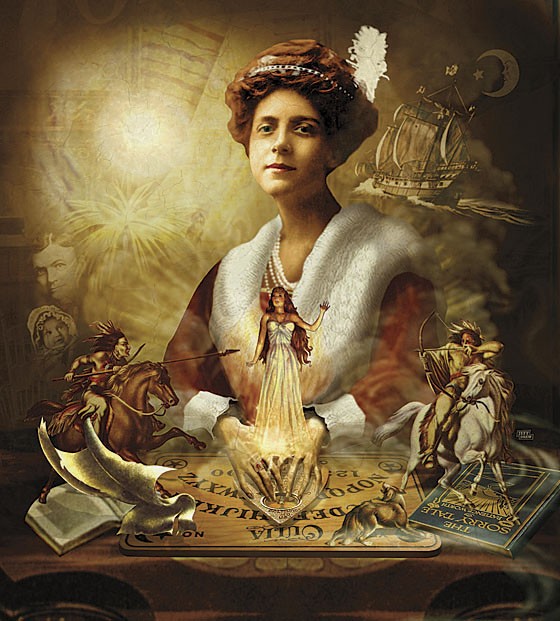In a St. Louis parlor room in the summer of 1913, two housewives bent over a Ouija board. Thirty-year-old Pearl Curran had recently lost her father. Her friend, Emily Grant Hutchings, urged her to try to contact him through the game. The women placed their hands on the board's heart-shaped planchette and asked if anyone was there. In the silent, humid room, the planchette's circular eye began to move across the board's letters — but it wasn't Curran's father.
"Many moons ago I lived," the board spelled out. "Again I come. Patience Worth my name."
At the turn of the 20th century, the country was obsessed with spiritualism. Séances and hypnotism were forms of entertainment in the households of the middle- and upper-classes, and the interest in contacting ghosts was as fervent as the interest in debunking so-called psychics and mystics. It was in this era that Curran first took up the Ouija board and met Worth, a spirit who would stay with her until her death in 1937. Across two decades of medium sessions, Curran penned seven novels supposedly dictated to her by Worth — along with countless poems and essays — in total, more than four million words from beyond the grave. Throughout their shared career, Curran faced many critics who sought to disprove Worth's existence.
"The mystery of it all fascinated me," says Daniel Shea, professor emeritus of English at Washington University and author of The Patience of Pearl: Spiritualism and Authorship in the Writings of Pearl Curran.
The daughter of a newspaperman, Pearl Lenore Pollard grew up with knowledge of words but was by all accounts relatively uneducated, with little interest in literature and books. She married John Curran, a St. Louis immigration official, at age 24 and spent her days tending to the domestic chores of a housewife. Several years into her marriage, Curran became friends with Hutchings, the wife of the secretary of the Tower Grove Park Board, and like many bored housewives of the time, began exploring spiritualism.
In July 1913, the voice of Worth — a woman who died in the 17th century — first appeared through the Ouija planchette. Worth revealed that she was the spirit of a Puritan who had traveled from Dorsetshire, England, to Nantucket Island, Massachusetts, before being killed in a Native American raid. An aspiring author in a new land, Worth lamented to Curran that her death occurred before she could complete her life's work. Through the Ouija board, Curran offered to help with Worth's unfinished business. The two women, one living and one dead, began to correspond regularly.
In her transcriptions through Curran, Worth revealed very little of herself. She conveyed scant information about her voyage from Dorsetshire to New England, transmitting only, "About me, thou wouldst know much. Yesterday is dead. Let thy mind rest as to the past." Her archaic diction convinced observers that the voice was most certainly not Curran's. Worth's spirit became known for her cleverness and witty turns of phrase. She often played with observers, especially those who voiced their doubts, such as when a doctor asked Worth to overturn the board so he could see the underside and she spelled out, "Thee'lt bump thy nose to look within the hopper." She was also known to communicate in anachronistic maxims and aphorisms, spelling out adages such as, "An old goose gobbles the grain like a gosling," and, "Dead resolves are sorry fare."
Given the time's popular interest in spiritualism and the existence of four major daily newspapers in St. Louis, word of Curran's medium sessions with Worth spread quickly. Curran's husband's prominent job helped too. Writers, psychologists and those occupying the highest echelons of society would come to the Currans' parlor room to witness Pearl at the Ouija board, dictating words letter by letter to her husband John, who dutifully wrote them down. Onlookers could sometimes observe the penning of one or two complete poems in a single session. That drew the interest of Casper Yost, an editor at the St. Louis Globe-Democrat, who wrote a series of articles for the newspaper that became the 1916 book Patience Worth: A Psychic Mystery. In it, Yost describes Curran as "a young woman of nervous temperament, bright, vivacious, ready of speech. She has a taste for literature, but is not a writer, and has never attempted to write anything more ambitious than a personal letter." He paints Worth as an intelligent spirit by contrast, one whose mind was "at once keen, swift, subtle and profound. There is not once but always a sustained level of clear thought and fine feeling." For this reason, and because Worth also wrote with such authority about the 17th century, Yost believed what he was witnessing to be a true supernatural phenomenon. He wrote, "[Worth] is surprisingly familiar with the trees and flowers, the birds and beasts of England. She knows the manners and customs of its people as they were two or three centuries ago, the people of the fields or the people of the palace."






